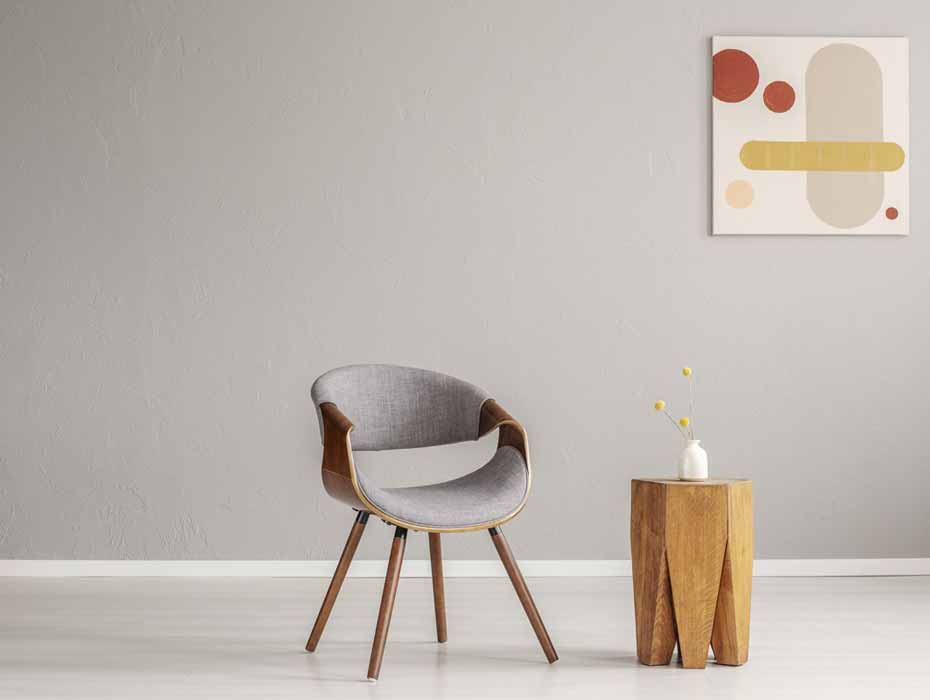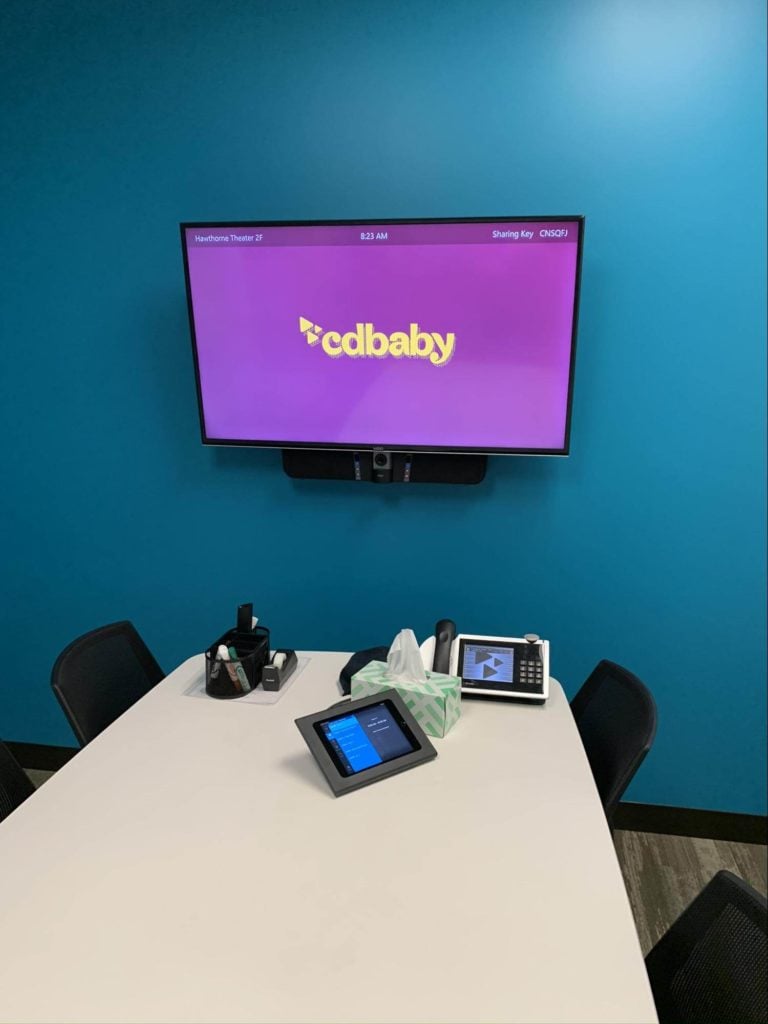Updated July 2021
No matter what size business you’re in, from a startup with a team of five to a mid-sized business with hundreds of employees, the conference room is a key place where decisions get made.
It’s true that COVID is changing the way that people work—while some businesses transition to fully remote work, others are downsizing while still maintaining some physical space for people to gather and work together in-person.
For businesses that see the importance of preserving office space, the conference room is one that can’t be forgotten about.
But just because we’ve all seen and have stepped inside these rooms before, that doesn’t mean they’re all built the same. The best conference rooms are set up to facilitate smooth interactions between the people within it. Everything in a well-designed conference room should be intuitive to use, and yes, we’re talking about the technology and equipment in there as well.
Throughout the last decade, there’s been a shift in what a functional conference room setup looks like. If you’ve set foot in different rooms over the years, chances are you’ve seen it firsthand. Moving away from drab, outdated rooms with more tangled cords than chairs, businesses are being more cognizant of creating uncluttered space with technology that inspires productivity.
Whether it’s your first time setting up a new room or perhaps you’re just looking to upgrade an existing space, this article has you covered on everything you need to know about how to organize your team’s new favorite meeting space.
In this article, we’ll be covering:
- 6 things to consider when setting up a conference room for the first time
- A detailed checklist for how to configure and maintain a conference room
🎧 Do you have the right headset equipment for your next conference call? Download this step-by-step buyer’s checklist to find out.
6 things to consider when setting up a conference room
An easy-to-use, functional conference room allows people to move in it freely while providing the tools needed for participants to collaborate with one another. Here are 6 ideas to consider when setting up your next conference room.
1. Layout
The overall layout of a room considers what the people within that space will be doing. For instance, hosting a presentation versus facilitating a workshop will likely call for different ways in which you’ll need to set up the chairs and seating in that space. For the majority of businesses, you’ll want to consider two styles:
The boardroom style: With seating around a centralized table or set of tables grouped together, this layout is best for in-person meetings with optional remote participation since everybody is visible to one another and there’s open space in between everyone to facilitate undisrupted conversation:

The U-shape style: With tables placed against each other to form the shape of a “U”, participants sit around the outside of the table leaving an open space for a screen or whiteboard to be the main focus. This is particularly beneficial for meetings that involve key remote participants or are driven by presentations. For workshops, this layout is also ideal as it allows a facilitator to interact directly in the middle of the space:
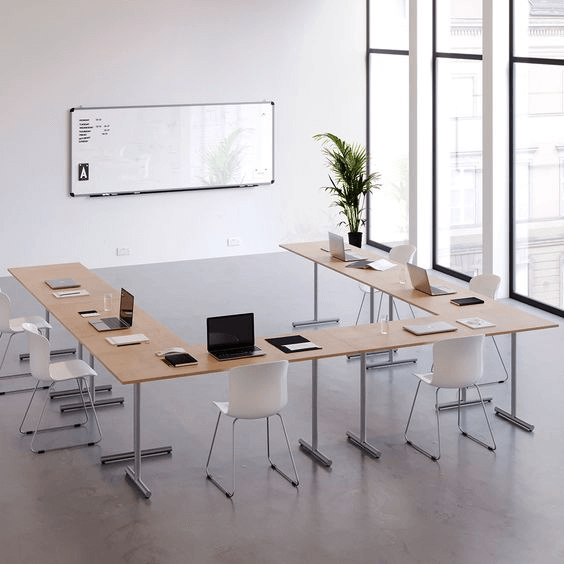
If you’re creating a new or updating an existing layout during a time of physical distancing, be sure to space chairs apart accordingly, and if space permits, bring in an extra table to break out the number of seats per table grouping.
2. Furniture
If you are setting up multiple conference rooms, it can be helpful to differentiate them visually so that people don’t get them mixed up (ever been late to a meeting because you’ve had trouble finding a room? We’ve all been there). You can explore different themed rooms such as by playing around with colors (using varied colored walls) and materials (dressing up a room with plants or different types of lighting fixtures):
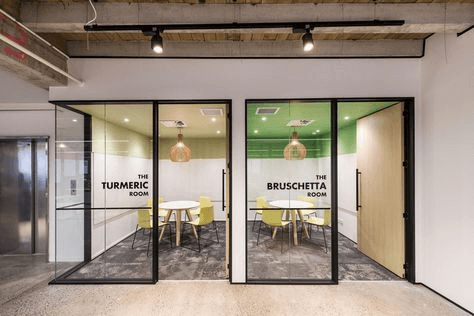
An example of a themed room
As with the rest of your office furniture, chairs in the conference room should be ergonomic and be comfortable to sit in for long periods of time (imagine being uncomfortable in your chair for a full-day planning session!). Although high-end furniture is considered nice-to-have rather than need-to-have, subtle choices can make a big difference in mood and productivity. For instance, chairs with wheels can subtly encourage people to tuck back into the tables before leaving to “reset the room” as a courtesy to others who share the space.
3. Equipment
In addition to setting up the chairs and tables, a modern conference room should have the right technical equipment, which makes it easy to host virtual conferences.
In addition to your standard tv screen for projecting presentations, a robust video and audio system designed specifically for business-grade video meetings is also important to have in the space. For instance, a camera that supports a wide, 120-degree view of everyone in the room makes virtual meetings that much easier to follow for remote attendees.
These days, especially when working in an Agile environment, collaboration is king. Whiteboards are a popular way to allow people to share ideas freely with one another, especially when the ideas are visual in some way.
Whiteboard sizes aren’t just limited to what you can fit in the back of your car! Some highly collaborative rooms use whiteboard paint so that every wall can be made into a surface for writing on.
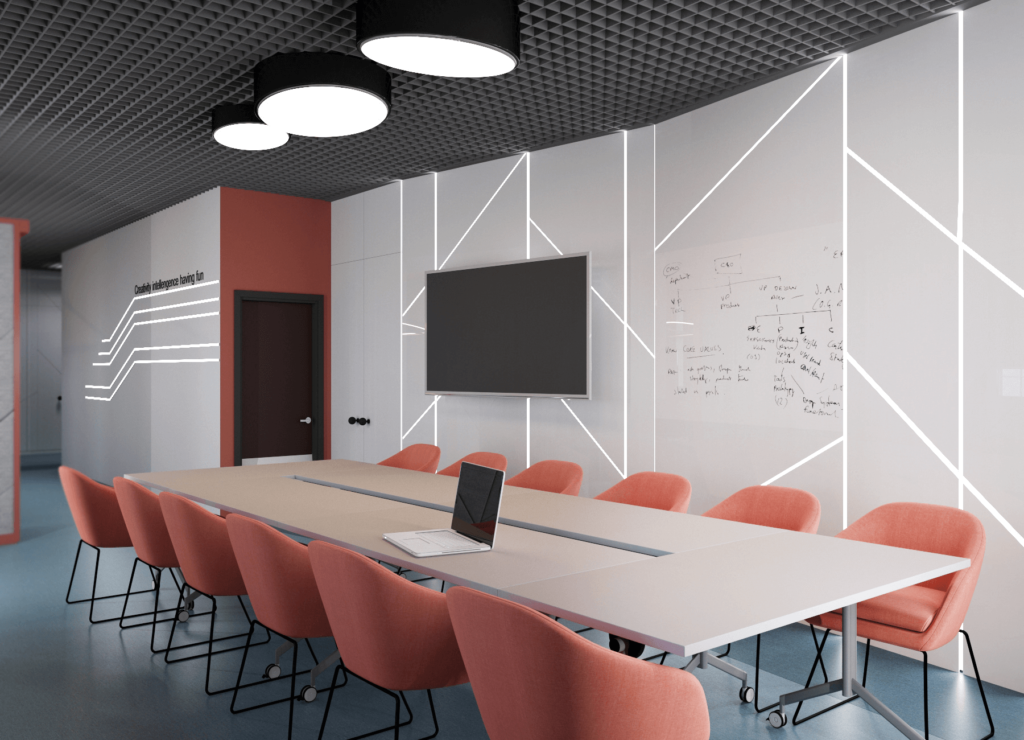
There are also “smart” whiteboards with technology that enables touchscreen drawing and automatic saving to a computer, which can be made editable later. Note that these more advanced technologies might not be suitable and feasible for you as a small business, especially if you don’t have a need for high levels of collaboration on a day-to-day basis. That’s why you should be clear on your goals upfront when planning for what types of equipment are needed for your space.
4. Tools
When it comes to running a smooth meeting, conferencing tools can make or break the experience. Traditionally, physical phone systems were the main ways of setting up conference calls, but configuring these can be costly and confusing, especially for small business owners who don’t (yet) have an IT team to get these up and running.
RingCentral Rooms™ offers an alternative conferencing system for the modern business that’s entirely operated through the cloud and doesn’t require clunky physical hardware to maintain. Using just an iPad as a controller, you can start a meeting in seconds, as well as send invitations on the spot to last-minute participants. Here’s how CD Baby’s team does it:
With the ability to integrate with your calendar, you can click an event to start a meeting right away without having to enter a string of numbers and access codes to join. By eliminating the need for tedious dialing processes, technical challenges are reduced to a minimum, allowing everyone to focus on the discussion rather than IT difficulties that traditional conferencing setups can bring.
Another productive tool to use is a conference room scheduling software, such as JOAN. How many times have you walked into a room that was already double or triple booked? What about walking into a room that is only equipped to sit half the number of people you expected to come?
These problems are common yet easily solvable by matching room amenities to meeting needs, and having a booking schedule so that everyone knows when a room is available to be used. Don’t leave it up to chance—instead, invest in a ready-to-use scheduling software.
🕹️ Get a hands-on look at how RingCentral works by booking a product tour:
💰 You can also use this calculator to see roughly how much your business could save by using RingCentral to support your team’s communication with each other—and clients.
5. Accessibility
Wayfinding: When people are looking for a conference room, they should be able to quickly find its name in an easy-to-spot location with clear signage or lettering in front of the room. In addition to visual cues, physical cues (such as Braille) might be beneficial as well.
Equipment placement: Be thoughtful about the placement of whiteboards, screens, and digital displays. While it might be tempting to just eyeball where and how high to install these, remember that not everybody can reach these tools in the same way. Make sure the equipment you have in the room can be accessed by everybody, including your seated attendees, with ease.
Entrances and passageways: Doors should be wide enough to pass through by anyone, including those with wheelchairs, and be within reasonable weight to open and close. Particularly for smaller rooms, mind the space between the furniture that people (particularly seated users) have to navigate through. Even though more tables and chairs can fit, that doesn’t mean they necessarily should!
6. Rules
To make sure that every meeting in the conference room runs smoothly, a basic set of rules or guidelines can be provided to let everyone know the basics of how to use the shared space. These include things such as Wi-Fi network information, ways on how to book the room, and a resource (either a contact number or email or even just a reading link) for general support. During COVID, consider also including a set of health and safety guidelines on how to maintain proper physical distancing and regular sanitation.
Conference room setup checklist
Ready to get started with setting up your conference room? Here’s a detailed checklist you can go through that covers all the fundamental steps you’ll need to take within the 6 ideas just shared:
Layout
- Assess the needs of the space—what sort of meetings, workshops, or types of events will be held and how much seating is needed?
- Get the full measurements of the room you have to work with.
- Create a blueprint for how you plan to set up the table, seating, and equipment.
Furniture
- Find the right tables and chairs and consider how the size and quality of them will function in the space: Are the tables large enough for the needed number of chairs surrounding them? Are they too large, leaving too much room between attendees? Do table and chair heights match? Are chairs comfortable yet stable enough for prolonged sitting?
- Have your light switches easy to find—the ability to control or dim lighting is important for those hosting presentations. For windows that let in natural light, consider mounting curtains to give attendees the ability to control glare.
- Consider sound-absorbing panels—sound travels differently in different office spaces. Open-plan offices that foster collaboration also tend to produce higher overall noise levels, so if you find that some of this noise might leak into your huddle rooms, you can explore panel options for sound absorbency.
Equipment
- Make sure the office’s Wi-Fi connection is strong within your conference room.
- Find the right TV screen—depending on the size of the room, you’ll want to have a large enough screen so that the furthest seated person can still see details within reason. Here’s a handy calculator that tells you how big of a screen you need depending on your room size.
- Functioning audio and video equipment—make sure your conference phones and speakers are functioning properly with the right connections switched on. Teams wanting to create a unified conferencing experience might opt to choose to install a wide-angle camera for the room to be used during video conferences. In situations where multiple presenters need to share their screen, you might want to opt for wireless presentation solutions using Wi-Fi to share screens rather than passing around multiple cables.
- Assess the need for smart technology—depending on your initial assessment on the primary needs of the room, consider the role of smartboards, voice assistants (like Amazon Echo or Google Nest), or smart lights.
- Gather general stationery like whiteboard markers and erasers, sticky notes, pens, and notepads as well as general tech accessories such as chargers and batteries.
Tools
- Assess what types of video conferencing needs you have—for instance, do you need a mobile-friendly tool (for attendees to join via mobile or tablet)? How about the ability to screen record?
- Choose the right video conferencing software based on your needs—an easy-to-use tool that’s easy to pick up and integrates with your existing calendar and email client makes it that much easier for your team to adopt!
- If you’re a small business with limited IT support, look for a tool backed by strong customer service support or offers self-service resources.
- Choose the right conference room scheduling software—advanced scheduling tools can provide you with analytics on how often rooms are used, how many no-shows there were in a given timeframe, and what equipment exists in your most popular rooms. If you have just one or two main conference rooms, opt for a more basic tool that meets your main needs and graduate up as needed.
Accessibility
- Create clear signage outside of the room—make room names highly visible and consider adding braille as an option.
- Fix equipment at heights that are easily accessible by everyone, including possible seated users.
- Clear pathways in the space for attendees to navigate and move around in without feeling trapped by the furniture or equipment.
Rules
- Display the Wi-Fi network information—this makes it easier for infrequent users and visitors to connect their personal devices to your office’s internet connection.
- Share general housekeeping rules for users of the space. These include things such as how to book meeting rooms, how to use virtual conferencing tools, and how to keep spaces organized (for instance, “please tuck chairs back in before leaving”).
- Share health and safety guidelines (for example, how to prevent the spread of COVID in the workplace).
Final tip on setting up your next conference room…
At the heart of any conference room is the collaboration that takes place within it. By finding the right mix of furniture, equipment, and tools for your business, you can create an environment that naturally facilitates discussion with ease and comfort.
Plus, don’t forget that personal preferences exist in any meeting space! Crowdsource ideas and suggestions from your team so that all voices are heard and represented throughout the process of setting up your conference room. The greatest rooms don’t have to look the nicest or have the latest technology, but at its core it should be an inclusive space for everyone to share.
Originally published Aug 01, 2020, updated Oct 08, 2021
